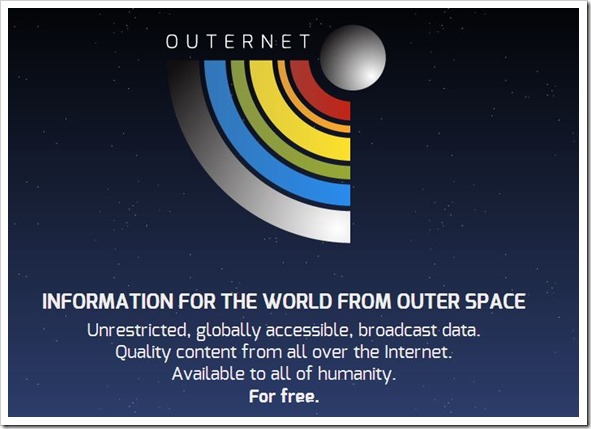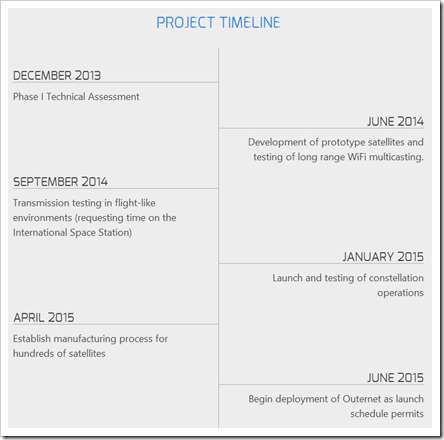Outernet: Free Internet to the World Via Satellites!
At the canteen of IIM-A is a board which reads TANSTAAFL meaning ‘There Ain’t No Such Thing As A Free Lunch.’ But life is full of pleasant surprises and this is one: A New York based non-profit organization called Media Development Investment Fund (MDIF) has announced its intention to build an “Outernet”—a global network of cube satellites broadcasting Internet data to virtually any person on the planet—for free. The idea is to offer free Internet access to all people, regardless of location, bypassing filtering or other means of censorship.
And that is Outernet…

Why free WiFi? Around 40% of the people in the world today are still not able to connect to the Internet— not just because of restrictive governments such as North Korea or China —also due to the high cost of bringing this service to remote areas.
An Outernet would allow people from Siberia to parts of the western United States to remote islands or villages in Latin-America or Africa to receive the same news as those in Los Angeles, New Delhi, Tokyo or Sydney.
Freedom of expression: Article 19 of the Universal Declaration of Human Rights says ‘Everyone has the right of freedom of expression.’ In today’s digital age, the Internet has grown in size and importance – human rights organizations and others promoting freedom of expression propose that access to the information that the Internet can provide, is a basic human right. What they suggest is that restricting access to the Internet is a violation of human rights.
Contents [hide]
How will MDIF do it?
By bypassing the ability to restrict access—MDIF is proposing that hundreds of cube satellites be built and launched to create a constellation of sorts in the sky, allowing absolutely anyone with a phone or computer to access Internet data sent to the satellites by several hundred ground stations!
Technology?
Data casting technology which involves sending data over wide radio waves would be used. At least in its initial stages, the constellation of satellites would broadcast data received in a continuous loop until new fresh data arrives. Broadcasting will be done using already accepted international standards such as UDP (User Datagram Protocol)-based WiFi multicasting, DVB, and Digital Radio Mondiale. The network would be a one-way for starting.
What to broadcast?
News, agricultural info, educational courseware, free applications and emergency info in case local cell networks fail.
Project Lead of Outernet Syed Karim says: ‘We have a very solid understand of the costs involved, as well as experience working on numerous spacecraft. There isn’t a lot of raw research that is being done here; much of what is being described has already been proven by other small satellite programs and experiments. There’s really nothing that is technically impossible to this.’
Funding?
It’s not very clear how much MDIF has been able to collect for the project, but acknowledge that building such a network would not be cheap by any measure. Such satellites typically run $100,000 to $300,000 each to build and launch.
Timeline?
The timeline for the project calls for deploying the initial CubeSats can be as early as mid-2015. Outernet project also aims to ask NASA for permission to test the technology on the International Space Station.

Eyewash or Genuine?
Around us, there is a huge clutter of the powerful terrestrial networks which would stomp all over the signal from space. Also, what exact device specifications are needed to intercept the data packets which the CubeSats would transmit is not very clear.
Challenges?
Such projects are in the limelight for their noble visions but lack of funding throws them off-track. Also, telecom operators would surely try their best to shut down the project before it is even off-ground! And then there are people who completely squash the idea. Here is a HAM Radio operator having 30 years of experience who explains that this is not feasible and is best described as ‘fantasy’. On Reddit.com, he shares his thoughts in pretty strong language:
“As a HAM radio operator for over 30 years I can say with great certainty that this is a MASSIVE load of cr**!. These guys have nothing but vapor. Wifi lacks the power to work from satellite, and the round trip travel time will cause the TTL timer to expire, causing nearly every packet to be discarded unless both the satellite and the ground station have customizations in the radio firmware.
Also, EVERY participating ground station is going to need a BIG, high-gain directional antenna, with an accurate tracking system to follow the satellite as it passes over, just as EVERY other low earth orbit satellite does. The radio will require the facility to adjust for Doppler shift, which exactly ZERO wifi radios have.
These guys are COMPLETELY high on crack if they think that they can go from concept to LAUNCHING DOZENS OF F***ING SATELLITES INTO SPACE in ONE AND A HALF YEARS!”
Conceptually, this is not an alien idea. Google has been working on a similar project called “Project Loon” for quite some time. And given Google’s might, there sure is some weight in this idea.
Such projects by non-profit organizations are necessary so that we are not slaves to the corporate. In this era of Edward Snowden, the veil of secrecy and shackles of capitalism should be atleast shaken, if not broken!

[…] called Media Development Investment Fund (MDIF) has announced its intention to build an “Outernet”—a global network of cube satellites broadcasting Internet data to virtually any person on the planet—for […]